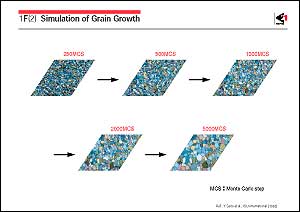Almost all metallic materials that
have been put into practical use consist of polycrystals and
contain grain boundaries. As a grain boundary possesses excess
energy, so the area of the grain boundary tends to reduce, provided
that the temperature is maintained at a suitable level for the
atoms to migrate. This is the mechanism for crystal grain growth
at high temperatures, and the process can be simulated by a computer
on the basis of this principle.
The photograph shows an evaluation of the changes in crystal
grains which have occurred within a period of time for a two-dimensional
triangular lattice with 200×200 lattice points. The condition
at which each lattice point has a random orientation is regarded
as the initial state, and the change in orientation at each lattice
point when maintained at a given temperature is traced using
the Monte Carlo method. The area consisting of lattice points
having the same orientation represents the size of the crystal
belonging to the same grain. The numerical figures represent
the Monte Carlo step and correspond to the elapsed time, while
different colors show different orientations. The photograph
illustrates the process of a normal grain growing in an average
manner over a period of time.
Such calculations are made by changing the value of a factor
which affects the initial state and the grain growth. By comparing
the results of the calculations with those of experiments, it
is possible to evaluate the most accurate values for each factor
and to discuss the influence on grain growth. The grain size
influences the principal properties of a steel material, such
as its strength and toughness. Therefore, a major development
area for the future will be to clarify the factors that govern
grain size and to establish a method of controlling the grain
size. |
|
 |
 |
 |
|
|